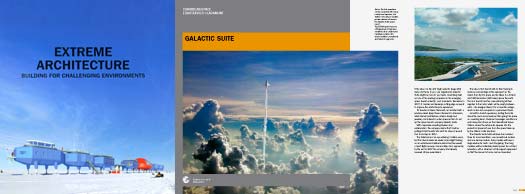Book
Extreme Architecture
GALACTIC SUITE
(UK)
GALACTIC SUITE
‘Pages extracted from Extreme Architecture by Ruth Slavid, to be published by Laurence King Publishing, Autumn 2009. Text ©Ruth Slavid. Design ©Laurence King Publishing.’
If the idea of a trip with Virgin Galactic (page 186) feels a bit tame to you, one organized by Galactic Suite might be more to your taste. Describing itself as ‘one of the leading companies in the emerging space tourism industry’, and, founded in Barcelona in 2007, it ‘creates and develops cutting-edge concepts to improve the orbital tourism experience’.
Its founder is Xavier Claramunt, an architect with a practice called EQUIP Xavier Claramunt in Barcelona, which blends architecture, interior design and jewellery. His interest in outer space led him to set up the space tourism company Galactic Suite.
With impressive-sounding backers and collaborators, the company claims that it will be putting its first tourists into orbit for stays of around four to six days in 2012.
The ticket price is an eye-watering 3 million euros, but this does include 16 weeks of pre-fight training on an undisclosed Caribbean island and two weeks of post-fight recovery. Some holiday. But, apparently, by the end of 2007 the company had already received 38 pre-reservations.
The idea is that tourists will do their training in luxurious surroundings at the spaceport on the island, then fy into space and be taken to a hotel in orbit 450 kilometres (280 miles) above the earth. The four tourists and two crew will bring all their supplies to the hotel, which will be empty between visits – the designer likens it to a mountain refuge, which is also not occupied on a permanent basis.
As befits a tourist experience, visiting the hotel should be much more luxurious than going into space on a working basis. Claramunt envisages conditions a world away from those on the International Space Station, where the astronauts squeeze into the pockets of space left over from the space taken up by the station’s vital functions.
The Galactic Suite hotel will have five modules: three for accommodation, one recreational module and one service module. Every module will have a large window for earth- and star-gazing. The living modules will be individual private spaces for rest and relaxation, with a minimum of life-support equipment so that the amount of room can be maximized.
The recreational module will allow the residents to enjoy sports under micro gravity conditions. Facilities will include space cycling, treadmills and resistance equipment. More prosaically, the toilets and sickbay will also be in this module, as well as the ‘space spa’, which the designers describe enticingly as ‘a recreational water activity inside a bubble 2 metres (6.5 feet) in diameter’. The service module, as well as housing the bulk of the life-support equipment and the docking ports, will be where group activities take place, including meals and sending transmissions to earth.
In all the modules, the technical equipment will be concealed behind undulating walls, which the designers describe as like ‘a hilly Tuscan landscape covered in the most glamorous, sensual materials suitable for use in space’.
The developers have not yet decided on their final choice of vehicle to transport the tourists, as they say that there are several projects under way to develop private space-fight vehicles. Initial access will be by Soyuz launches from Baikonour in Russia, but eventually there will be dedicated vehicles travelling from the Caribbean resort. These will be more luxurious than current spacecraft and Galactic Suite are looking at the use of Maglev (magnetic levitation launch technology) as a possible option in the future.
Ironically, however, the longest part of the experience will be on earth, so the design of the spaceport will be key – and, of course, a little less speculative since we can all understand how key elements, such as the plumbing, will work.
One part of the spaceport will be a luxury hotel, a field that Claramunt understands since his practice has considerable experience in hotel design. This, however, will be more ambitious than the standard urban hotel, with some floating suites and others hanging from cliffs. There will be a total of 200 rooms to accommodate not only the space tourists and their families but also more casual visitors who want to witness the whole procedure without actually going into space themselves.
The technical area will have all the facilities for take-off and landing, plus a landing area for private jets, maintenance facilities, and a harbour for deliveries of technical equipment and fuel. The training area will include a human centrifuge. The recreational area will partly be geared towards day visitors and partly to the space tourists’ families, and will have a platform overlooking the launch and landing area.
In order to make space tourism a reality there are enormous technical challenges to overcome, as well as the challenge of providing the type of experience that is way beyond the comfort level of current stays in space. Would the very well-heeled put up for six days with sanitary conditions and food that would make a backpacker’s hostel sound like luxury? Can these issues be resolved? The reports from the first visitors may make entertaining reading.

